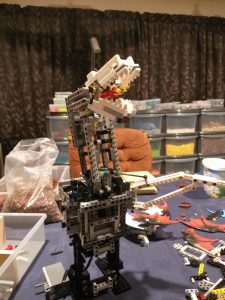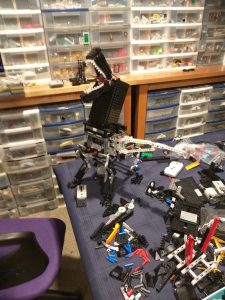An Interview with Jason de Vries – the designer of the Dragon called Snakehorns the Swamp Lurker.
Snakehorns the Swamp Lurker.
Interview conducted by Rachel de Vries
Where do you live? Rolleston, New Zealand
What is the first LEGO set you ever owned? Michael Mouse and his new car. Fabuland set number 328, from 1979. And I still own it as a complete set.
What do you like to collect when it comes to LEGO? Technic sets – I own somewhere around 200+ sets (no doubles). I also like the Ideas range and Modular buildings. I would love to one day own the entire Technic range and full Modular collection.

How long have you been building MOCs (My Own Creations)? Technically all my life – When I was a child I loved making my own creations with my childhood collection (as do most children). As an adult since 2015 and it all started because my wife challenged me to a build-off to make a church scene and I ended up going overboard and built a Guildhall with a chapel that I displayed at The Christchurch Brick Show (CBS) in 2015. After that, I got serious in MOC building and built some little animals, MECs, a large Tree, and the list could go on and on – and that was just 2015!
How did Snakehorns come about? Snakehorns is ideally is what I wanted to do with the first dragon I made for the 2016 CBS. But I didn’t feel I had the technical ability and confidence to make a moving dragon. For the 2018 show, I built a mechanical owl that had simple wing movement. In June 2019 I built a copy of the Owl skeleton and then started adding the extra mechanisms to get the sweeping wing. From there I added the neck movement, and over the next several days I added the jaw movement and rotating flame in the mouth. The name of the dragon came about as I wanted a horn. So using the LEGO horn parts and tried out various ends to the horn and ended up with the Ninjago snake (element number 98136). 
What was the hardest part of the build? There are 2 parts to the build which tested me. The primary one was the mechanism for the jaw. I spent a lot of time on this part. I found it hard to keep it looking clean while functioning well. I tried gears on the inside and outside (settling with the inside version with the drive shaft running through the neck). The gearbox at the back of the head ended up running the jaw and flame. It was also tricky synchronizing the jaw so they didn’t smash into each other and went up and down at the correct time. It took lots of trial, error, and patience, changing around the gears, the stroke length of the steering arm, and where that was placed in the jaw to make it work. Um, it probably took an entire 2 evenings’ work to sort this out. The other challenging part of the build was the legs. I was using the Technic rotation joints (part number 4425/4424) to articulate the shape of the legs. But with 2 of those units in each joint, it was still not strong enough. Inside these disks, I used different technic connectors to stiffen the joints. The other aspect of the build that is worth mentioning is that as I built I had to consider how to make it modular – meaning building it so I can take it apart easily to travel with it.
What was the most exciting or fun part of the build? Aside from the absolute satisfaction of getting all the mechanisms working, while I was putting the black base plates on for the skin, I had to use snot bricks and brackets against the technic subframe, changing the stud directions while enhancing the strength of the model while still making it modular, I was amazed at how the LEGO system worked SO well together.

What were your favorite and most unique parts use in Snakehorns? The use of catapults for the toes (part number 88289).
Please tell us some facts about Snakehorns. I went through 5 different wing versions before I settled on the final choice. I tried using Elves dragon wings (they ended up too heavy). I tried vinyl wings from the Ninjago Ultra Dragon (they just didn’t look right). Finally, I settled on a custom-cut fabric wing panel.
Snakehorns is Modular – The dragon can break down into the following sections so that I can pack it up for travel (specifically to put in a suitcase to take to Skaerbaek Fan weekend, Denmark. There is the main body and neck, every leg and tail is removable, each wing comes off (is attached by 2 ball join pins and an axle with stop)
All movement (that is 2 movements on each wing, the swivelling of the neck, articulation of the jaw, and the rotation of the flame) comes from a single technic Power Function XL motor.  There are 2 power packs in the model. One is to power the movements and the other is the power the lights behind the eyes.
There are 2 power packs in the model. One is to power the movements and the other is the power the lights behind the eyes.
How many hours/weeks did it take to build? Over a 5 week period a good 50 ish hours.
How many parts do you think could be in the model? Jeepers I don’t know! I guess 2000+ parts.
How much does it weigh? 4kg
What are it’s dimensions? Width: 750mm. Length: 800mm (with tail out straight) Height: 600mm
Is there anything else you want us to know about Snakehorns? I enjoyed creating the eggs that are under the dragon along with using 5 LEGO themes (Ninjago, Starwars, Classic Space, Moana, and Friends) to create a scene at the feet of Snakehorns.
What do you see yourself building next? Ooooh, I don’t actually know, I feel this might stick around for a while because of the work I have put into it. I am hoping to be inspired by my trip to Denmark later this month for a future build. See more MOCs by Jason and Rachel on our gallery.
♥♥YOUTUBE: Check out Snakehorn the swam Lurker at this Youtube link. ♥♥






